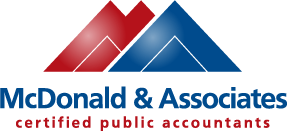The New Business Deduction
Stop worrying and start preparing
A new deduction is available to businesses with qualified business income (QBI). While that’s great news, new deductions (especially ones with lots of rules) can bring anxiety and confusion. Never fear! Ensuring you receive a maximum deduction will come down to providing the proper information. Here is some knowledge to help you cut through the confusion:
What is the QBI deduction?
In short, it’s a 20 percent deduction against ordinary income, taken on your personal tax return, that reduces qualified business income earned for most pass-through businesses (sole proprietorships, partnerships and S-corporations). It’s not an itemized deduction, so you can take it in addition to the standard deduction. To qualify without limitations, your total taxable income needs to be below $157,500 ($315,000 for married couples) for 2018. If your income exceeds the threshold, it gets complicated.
What you need to know:
- If your total taxable income is above the income threshold, your deduction may be limited or nullified. If your income is below the threshold, the calculation is pretty straightforward. If not, additional phaseouts, limitations and calculations come into play. The first limitation to consider is whether or not your business is qualified. Certain specified service trades or businesses (SSTBs) are excluded from the deduction altogether if taxable income is over the threshold. If your business is not an SSTB, other calculations related to W-2 wages and basis in qualified business property may be required.
- Schedule K-1s for S-corporations and partnerships have new codes. Businesses with partners and shareholders are now required to report information related to the QBI deduction on each Schedule K-1 they issue. Based on the draft versions of the forms, the new codes will be in Box 17 for S-corporations (V through Z) and Box 20 for partnerships (Z through AD). If you receive a Schedule K-1, check to see if the new codes have values associated with them. If not, contact the issuing business to correct the mistake. Schedule K-1s without the required data will delay your tax-return filing.
- Certain data needs to be collected. For the most part, the data required to calculate your deduction will be included on the normal forms needed to file your taxes. Here is list of common documentation to watch for that may be required to calculate your QBI deduction:
- Business financial statements
- Forms W-2 and W-3 issued by your business
- Purchase information related to business assets
- Schedule K-1s
- Forms 1099-B with cost/basis information
- The sooner you close your books, the better. The new deduction means more work. Knowing your final business net income as soon as possible gives you extra time to work through the additional necessary calculations. If your business is required to issue Schedule K-1s, even more time may be required.
- More guidance is expected from the IRS. In August, the IRS published guidance to clear up some of the confusion regarding the deduction, but it didn’t cover everything. The American Institute of CPAs (AICPA) responded with 11 specific items that still need to be addressed.
With proper planning and preparation, you can rest easy knowing that obtaining your shiny, new QBI deduction is in good hands.
As always, should you have any questions or concerns regarding your tax situation please feel free to call.
This publication provides summary information regarding the subject matter at time of publishing. Please call with any questions on how this information may impact your situation. This material may not be published, rewritten or redistributed without permission, except as noted here. This publication includes, or may include, links to third party internet web sites controlled and maintained by others. When accessing these links the user leaves this newsletter. These links are included solely for the convenience of users and their presence does not constitute any endorsement of the Websites linked or referred to nor does MCDONALD & ASSOCIATES CPAs have any control over, or responsibility for, the content of any such Websites. All rights reserved.



